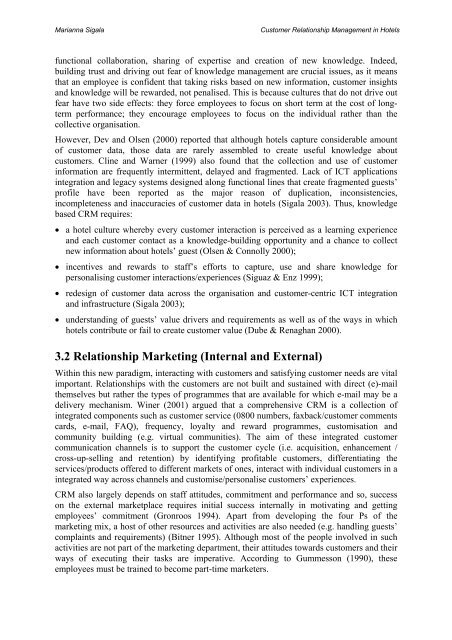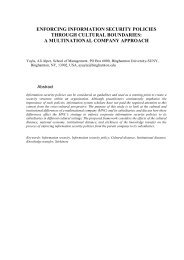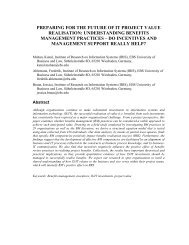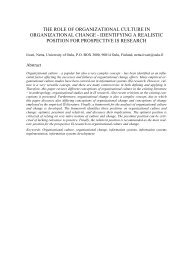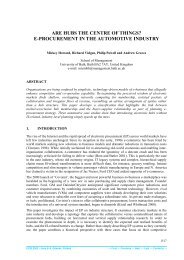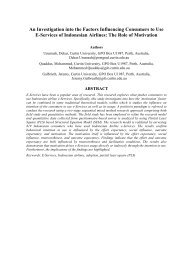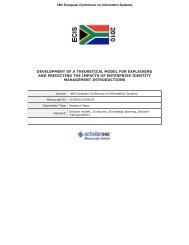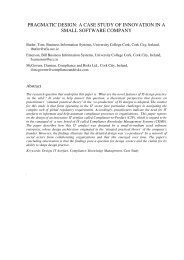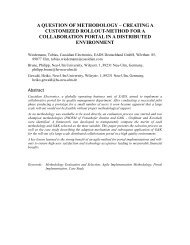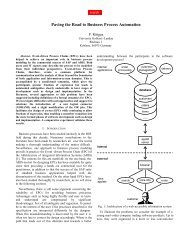Implementing Customer Relationship Management in the Hotel Sector
Implementing Customer Relationship Management in the Hotel Sector
Implementing Customer Relationship Management in the Hotel Sector
You also want an ePaper? Increase the reach of your titles
YUMPU automatically turns print PDFs into web optimized ePapers that Google loves.
Marianna Sigala <strong>Customer</strong> <strong>Relationship</strong> <strong>Management</strong> <strong>in</strong> <strong>Hotel</strong>s<br />
functional collaboration, shar<strong>in</strong>g of expertise and creation of new knowledge. Indeed,<br />
build<strong>in</strong>g trust and driv<strong>in</strong>g out fear of knowledge management are crucial issues, as it means<br />
that an employee is confident that tak<strong>in</strong>g risks based on new <strong>in</strong>formation, customer <strong>in</strong>sights<br />
and knowledge will be rewarded, not penalised. This is because cultures that do not drive out<br />
fear have two side effects: <strong>the</strong>y force employees to focus on short term at <strong>the</strong> cost of longterm<br />
performance; <strong>the</strong>y encourage employees to focus on <strong>the</strong> <strong>in</strong>dividual ra<strong>the</strong>r than <strong>the</strong><br />
collective organisation.<br />
However, Dev and Olsen (2000) reported that although hotels capture considerable amount<br />
of customer data, those data are rarely assembled to create useful knowledge about<br />
customers. Cl<strong>in</strong>e and Warner (1999) also found that <strong>the</strong> collection and use of customer<br />
<strong>in</strong>formation are frequently <strong>in</strong>termittent, delayed and fragmented. Lack of ICT applications<br />
<strong>in</strong>tegration and legacy systems designed along functional l<strong>in</strong>es that create fragmented guests’<br />
profile have been reported as <strong>the</strong> major reason of duplication, <strong>in</strong>consistencies,<br />
<strong>in</strong>completeness and <strong>in</strong>accuracies of customer data <strong>in</strong> hotels (Sigala 2003). Thus, knowledge<br />
based CRM requires:<br />
• a hotel culture whereby every customer <strong>in</strong>teraction is perceived as a learn<strong>in</strong>g experience<br />
and each customer contact as a knowledge-build<strong>in</strong>g opportunity and a chance to collect<br />
new <strong>in</strong>formation about hotels’ guest (Olsen & Connolly 2000);<br />
• <strong>in</strong>centives and rewards to staff’s efforts to capture, use and share knowledge for<br />
personalis<strong>in</strong>g customer <strong>in</strong>teractions/experiences (Siguaz & Enz 1999);<br />
• redesign of customer data across <strong>the</strong> organisation and customer-centric ICT <strong>in</strong>tegration<br />
and <strong>in</strong>frastructure (Sigala 2003);<br />
• understand<strong>in</strong>g of guests’ value drivers and requirements as well as of <strong>the</strong> ways <strong>in</strong> which<br />
hotels contribute or fail to create customer value (Dube & Renaghan 2000).<br />
3.2 <strong>Relationship</strong> Market<strong>in</strong>g (Internal and External)<br />
With<strong>in</strong> this new paradigm, <strong>in</strong>teract<strong>in</strong>g with customers and satisfy<strong>in</strong>g customer needs are vital<br />
important. <strong>Relationship</strong>s with <strong>the</strong> customers are not built and susta<strong>in</strong>ed with direct (e)-mail<br />
<strong>the</strong>mselves but ra<strong>the</strong>r <strong>the</strong> types of programmes that are available for which e-mail may be a<br />
delivery mechanism. W<strong>in</strong>er (2001) argued that a comprehensive CRM is a collection of<br />
<strong>in</strong>tegrated components such as customer service (0800 numbers, faxback/customer comments<br />
cards, e-mail, FAQ), frequency, loyalty and reward programmes, customisation and<br />
community build<strong>in</strong>g (e.g. virtual communities). The aim of <strong>the</strong>se <strong>in</strong>tegrated customer<br />
communication channels is to support <strong>the</strong> customer cycle (i.e. acquisition, enhancement /<br />
cross-up-sell<strong>in</strong>g and retention) by identify<strong>in</strong>g profitable customers, differentiat<strong>in</strong>g <strong>the</strong><br />
services/products offered to different markets of ones, <strong>in</strong>teract with <strong>in</strong>dividual customers <strong>in</strong> a<br />
<strong>in</strong>tegrated way across channels and customise/personalise customers’ experiences.<br />
CRM also largely depends on staff attitudes, commitment and performance and so, success<br />
on <strong>the</strong> external marketplace requires <strong>in</strong>itial success <strong>in</strong>ternally <strong>in</strong> motivat<strong>in</strong>g and gett<strong>in</strong>g<br />
employees’ commitment (Gronroos 1994). Apart from develop<strong>in</strong>g <strong>the</strong> four Ps of <strong>the</strong><br />
market<strong>in</strong>g mix, a host of o<strong>the</strong>r resources and activities are also needed (e.g. handl<strong>in</strong>g guests’<br />
compla<strong>in</strong>ts and requirements) (Bitner 1995). Although most of <strong>the</strong> people <strong>in</strong>volved <strong>in</strong> such<br />
activities are not part of <strong>the</strong> market<strong>in</strong>g department, <strong>the</strong>ir attitudes towards customers and <strong>the</strong>ir<br />
ways of execut<strong>in</strong>g <strong>the</strong>ir tasks are imperative. Accord<strong>in</strong>g to Gummesson (1990), <strong>the</strong>se<br />
employees must be tra<strong>in</strong>ed to become part-time marketers.


